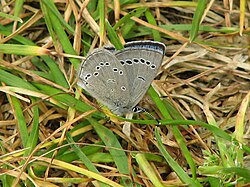| Silvery blue | |
|---|---|
 | |
| G. l. couperi, Ottawa, Ontario, Canada | |
| Scientific classification | |
| Domain: | Eukaryota |
| Kingdom: | Animalia |
| Phylum: | Arthropoda |
| Class: | Insecta |
| Order: | Lepidoptera |
| Family: | Lycaenidae |
| Genus: | Glaucopsyche |
| Species: | G. lygdamus |
| Binomial name | |
| Glaucopsyche lygdamus (Edward Doubleday, 1841) | |
| Subspecies | |
See text | |
Glaucopsyche lygdamus, the silvery blue, is a small butterfly native to North America.


